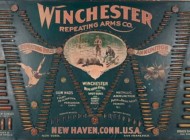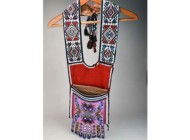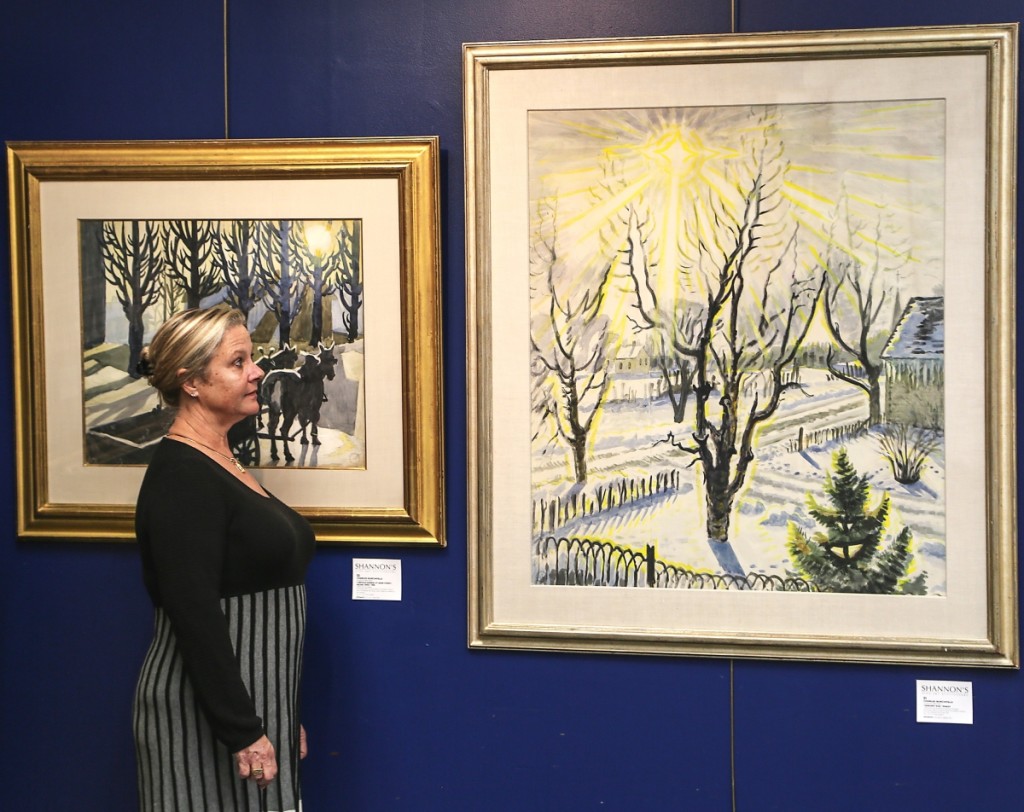
Managing partner Sandra Germain looks at her top lot, Charles Burchfield’s watercolor on paper “January Sun,” which sold for $380,000. After completing the work’s right side through the sun’s left edge in 1948, the artist returned to it nine years later to add more space to the left side, allowing the sun’s beams to shine in all directions equally.
Review by Greg Smith, Catalog Photos Courtesy Shannon’s
MILFORD, CONN.- “This was the best sale we have had in ten years,” said a glowing Sandra Germain, the managing partner at Shannon’s Fine Art Auctioneers, after her 177-lot October 28 sale. The auction did $3.6 million with nearly 80 percent of all lots sold. There were about 20 people in the room, all of them conduits to interested bidders on the phone, absentee and internet. Germain said the Covid-era format of appointment previews and telebidding has proved a winning formula for Shannon’s.
The sale was led at $380,000 by Charles Burchfield’s “January Sun,” an image of glowing radiance that douses the neighborhood outside the artist’s home in the yellow warmth of the sun. You could practically see Burchfield painting it, his eyes squinting at a blinding landscape that offers no shade at all – the sun shining through the leafless trees and reflecting upward off the white, monotone snow-covered ground – his narrow view obscuring the prickly details and illuminating the color instead.
Burchfield created the first iteration of the watercolor-on-paper in 1948 and returned to it in 1957 when he enlarged the work’s left side to include the full 360-degree view of the sun’s beams.
Catalogers at Shannon’s worked with Burchfield scholars Nancy Weekly and Scott Propeack to dig up his relevant journal entries on the work.
On January 21, 1948, he begins, “P.M. Sketch from the studio ‘porch’ – shortly after I had started, the wind increased bringing snow with it. I protected myself by setting up a big box at the west end and tacking above it a large sheet of corrugated board. The snow became so thick and so clogged up my paint box that I had to stop – but not before I had hurriedly set down the main points. It made a fine composition of areas and angles.” He continued writing on January 30, “P.M. Painting from my south bedroom window of view towards Millers: the sun from the south projecting its powerful rays into the northern winter.”
That was likely the last time he touched the composition until the mood struck him in January 1957. On January 17 he wrote, “Got out the ‘January Sun’ (1948)…I planned to enlarge…” The following day he wrote, “Mounted the ‘January Sun’ to its new shape.” Then on February 18, “P.M. – Got to work on ‘January Sun’. Slow and difficult but it did go fairly well at last – but not finished.” Lastly on February 19, “A.M. Finished work on ‘January Sun.'” The final work measured 39 by 33½ inches.
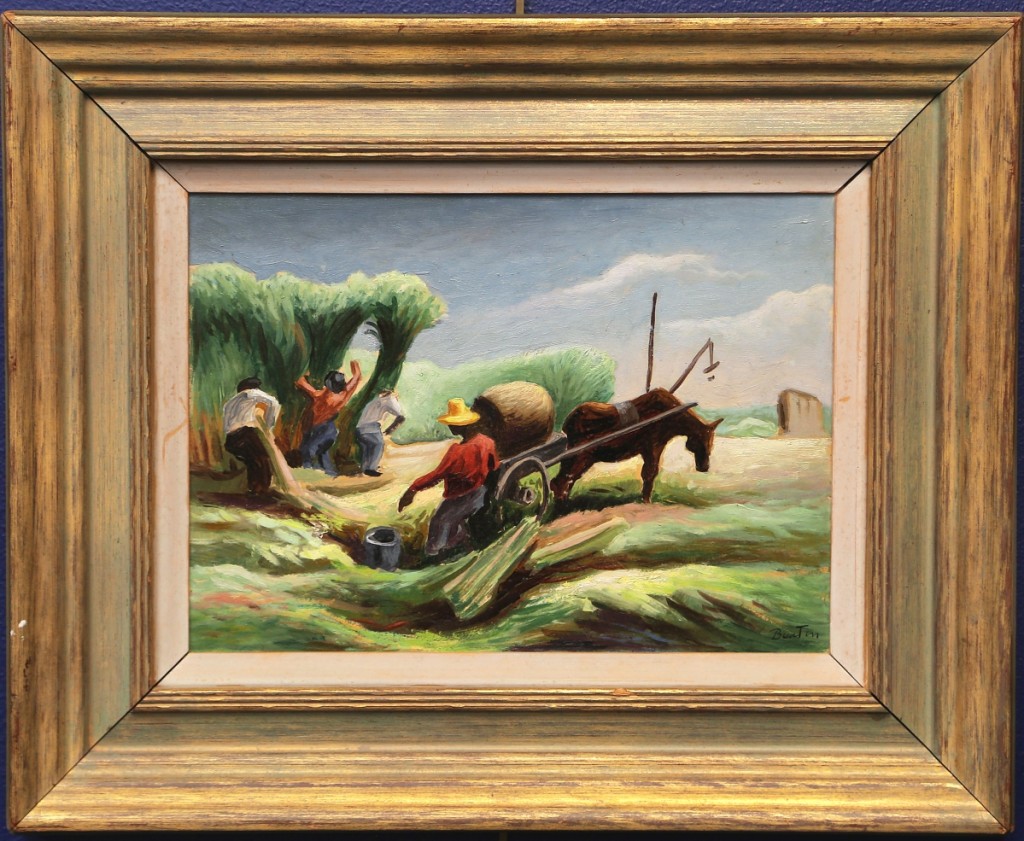
Thomas Hart Benton’s “Study for ‘Sugar Cane’” would sell for $275,000 to a Midwestern institution. The final and larger “Sugar Cane” painting is in the collection of the Thomas Hart Benton Trust and the artist appreciated it enough to choose it as the frontispiece for Matthew Baigell’s 1974 monograph on his work.
Both “January Sun” and “Lincoln Avenue at Main Street, Salem, Ohio,” – the other Burchfield in the sale -came from the same private collection in Connecticut. Germain said the American art collector who consigned them has worked with Shannon’s for more than 40 years and did much of their buying in the 1970s-80s.
Burchfield’s “Lincoln Avenue,” a 20½-by-25-inch watercolor on paper, sold for $100,000. The painting was completed earlier in 1916, the same year the artist received a scholarship to the National Academy of Design, which he resigned following only one day of classes and soon after returned home to Salem, Ohio. Burchfield historian Joseph Trovato included “Lincoln Avenue” in the artist’s 1970 catalog, where the author noted, “From 1915 to 1920 he did almost half of his total number of paintings – the best of which are among the most original achievements in American art.”
Catalogers again worked with Weekly and Propeack to find the relevant journal entry for the day the work was started, January 13, 1916: “Yesterday – A warm thaw day – Morning a burst of windy white sunshine – glittering rivulets running everywhere – streets blinding – houses & trees black silhouettes – Poplars at Lincoln – horses standing in blinding spot -.”
Though Burchfield did not appreciate being classified as a Regionalist, his work appeared alongside another by the king of that school, Thomas Hart Benton, whose 1943 “Study for ‘Sugar Cane,'” an 8¾-by-12-inch oil on board, sold for $275,000. The buyer was an unnamed Midwestern museum. The larger work, for which this preparatory painting was completed, resides in the Thomas Hart Benton Trust. The study was completed on or shortly after a 1943 trip to Louisiana where his gallery, Associated American Artists, had arranged for him a series of commissions, this scene not included – more extracurricular. On the finished work, Benton scholar Henry Abrams noted, “I suspect he was interested in the contrast between this sort of rugged agricultural labor, using simple tools, and the more modern, thoroughly mechanized work of the oil refineries he had just been documenting…” When Benton worked with Matthew Baigell to select the illustrations to appear in the artist’s 1974 monograph, “Sugar Cane” was selected for the volume’s frontispiece facing the title page.
“Study for ‘Sugar Cane'” was originally purchased from the artist by Samuel Sosland of Kansas City, Mo., a publishing executive who endowed the Nelson-Atkins’ curator of American art in the 1980s. It went into a New Hampshire collection before landing in the same private Connecticut collection as the Burchfields, from where it was consigned.
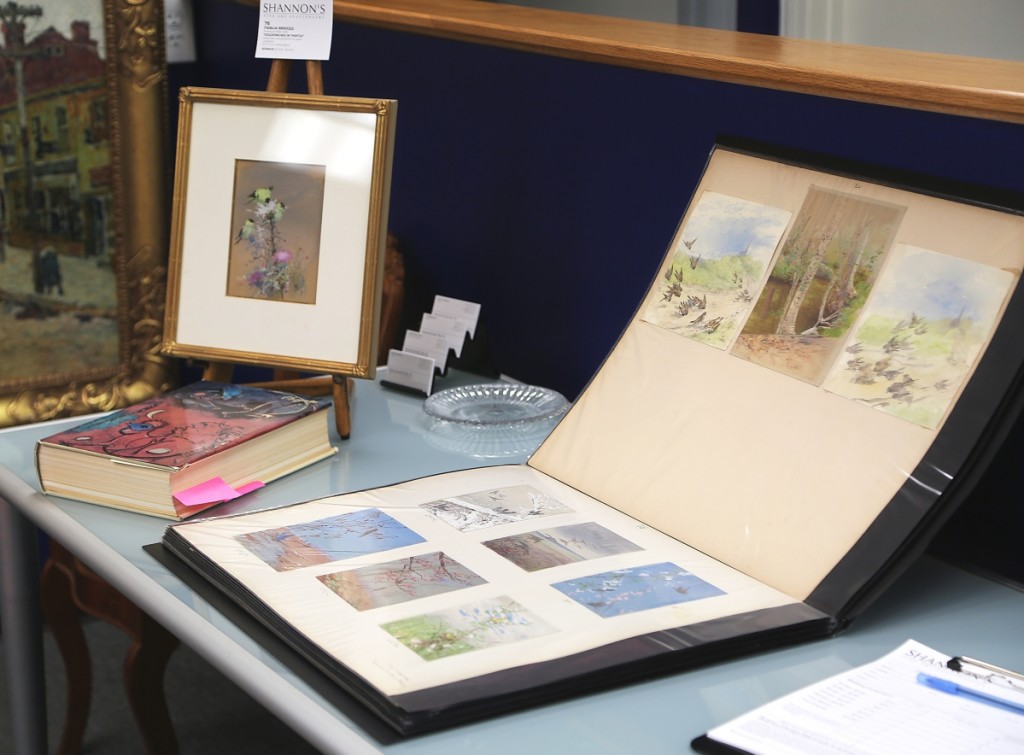
An auction record for American artist Fidelia Bridges was established at $181,250 for a portfolio of 96 illustrations. Shannon’s had set the artist’s previous high mark at $80,000 just six months ago. The portfolio is headed to a museum.
Still running with the Americans, we find a $181,250 result for a portfolio of works by Fidelia Bridges. It is an auction record for Bridges, surpassing an $80,000 record result at Shannon’s just six months ago. A museum was the buyer, something Germain had hoped for prior to the sale. Had it succumbed to the trade, it may have been broken apart. She said bidding came down to two determined institutions in the end.
“We’re thrilled it’s going to stay together and we look forward to a future exhibition on the artist,” Germain said. “It was an exciting compilation of work from different periods and different areas that she obviously thought something of because she saved them and kept them all together. An artist puts in their portfolio what they feel is their best work and that lent to the excitement around it.”
The portfolio contained 96 illustrations on 31 sheets, many depicting natural scenes of birds, flowers and landscapes. The works descended in the family of portrait artist Oliver Ingraham Lay, who met Bridges in Brooklyn in 1865 and lured her to his family’s hometown of Old Lyme, Conn., where she would return in the summers to paint. The works in Bridges’ portfolio are annotated with locations for New Jersey, Newport, Massachusetts, Old Lyme and the shores of Stratford, Conn., a mere six miles away from the auction gallery. Germain said, “I grew up going down to the Audubon and looking at the birds. It’s special that she painted there as well.”
Included in the portfolio was a portrait of Bridges by Lay, a study for one in the Smithsonian’s collection that was submitted by Bridges as her official portrait when she was inducted into the National Academy of Design. The catalog notes that Bridges regularly sold her work to Louis Prang, a publisher of cards, calendars and more, and many of the smaller sketches in the present portfolio are annotated with his name. The partnership established her as one of the most financially successful female artists of her time.
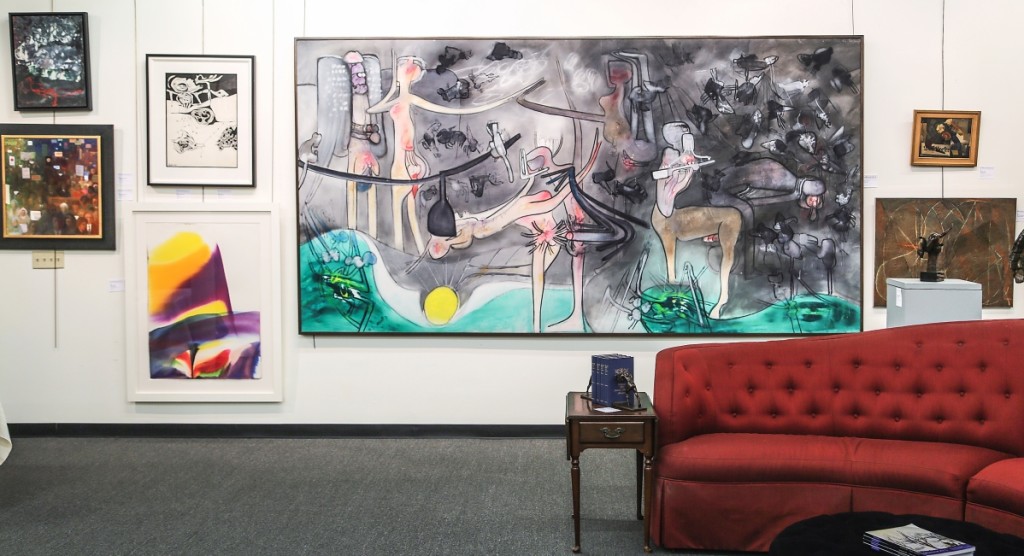
A monumental work by Roberto Matta took up nearly an entire wall as it stretched 149¼ inches in width. The sexual scene on the left relates to rebirth, Shannon’s specialist and appraiser Ali Danker said. That is balanced with the scene on the right, which focuses on death and decay. The untitled painting dated 1965 was originally purchased in Milan prior to the 1970s. It sold for $200,000 to a Midwestern museum.
There were other success stories for women artists in the sale. An auction record was set for Susan Watkins for “Woman Playing a Guitar,” a 1901 work that sold for $106,250 to a museum. Watkins attended the Art Students League under William Merritt Chase. He would paint a full-length portrait of her that now hangs in the collection of the Chrysler Museum of Art. Chase’s wife, Anna, wrote in a letter to Watkins that her husband regarded her as “the best woman painter living.” The present work was likely painted in Paris. Watkins died at the young age of 37 and her work is rarely offered on the market.
While walking through the preview gallery, we asked Germain what she thought was the most interesting painting in her sale. She turned to a wall that was dominated by a monumental Roberto Matta work and left us to consider her choice. The untitled oil on canvas measured a whopping 78 by 149¼ inches and dated to 1965. “Thematically, the painting relates to a familiar subject in art history with numerous parallels to Hieronymus Bosch’s ‘Garden of Earthly Delights,’ (1490-1500),” the catalog noted. Ali Danker, a specialist and appraiser for the auction house, broke it down as “Rebirth on the left, dreary on the right.” The work was purchased in Milan in the 1970s by the parents of the consignor, who eventually had it rolled and shipped to Los Angeles until its consignment. The painting was purchased for $200,000 by the same institution that bought the Benton study.
Other highlights in the sale included Henry Moore’s “Rocking Chairs,” a 1948 pencil, wax crayon, watercolor wash, pen and ink on paper that sold for $162,500. The work had provenance to Vera List, who provided the funds for Moore’s monumental bronze, “Reclining Figure,” that sits in a reflecting pool outside the Lincoln Center for Performing Arts in New York City.
“We had a good gauge of presale activity on most of the larger items leading in,” Germain said. “But we were thrilled overall with the results, most of our consignors did very well and I think that is due to the fact that we’re still producing a full color catalog for the buyers, which they still like, and we do a lot of work with targeted emails and phone calls prior to the sale that larger auction houses don’t offer. That’s what’s making the difference to us, our ability to provide that service to our customers.”
All prices reported include the buyer’s premium. Shannon’s next sale is an online-only fine art auction on January 20. The firm’s spring auction will be in April. For information, 203-877-1711 or www.shannons.com.




























